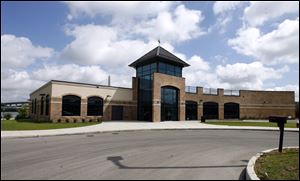
Maritime museum eyes Toledo
8/28/2009
The society says the Maritime Center on Front Street is a better site for its museum and library.
Toledo's downtown may be getting a world-class museum.
The Great Lakes Historical Society has met with the Toledo-Lucas County Port Authority Seaport Committee to discuss moving its museum exhibits in Vermilion to the Toledo Maritime Center on Front Street in Toledo's Marina District.
"The goal of this experience would be to create a national Great Lakes maritime museum," society executive director Chris Gilchrist said.
The society has operated a museum and research library in Vermilion for decades and with 2,350 members in 47 states, is the largest Great Lakes maritime historical association.
The society has been hoping to to move for several years so that it could expand its exhibits into a larger facility and reach more visitors. Initial discussions included sites such as Lorain, but "one that we kept coming back to was the Toledo maritime center," Mr. Gilchrist said.
If the society can move the Willis B. Boyer Museum Ship from the Maumee River near International Park to a slip by the museum site, Mr. Gilchrist said he hopes to create "the ultimate shipwreck experience."
The Boyer is one of the most important historical Great Lakes vessels and the sole survivor of the famous Great Lakes storm in 1913. When built in 1911, it was called the Col. James M. Schoonmaker and was the world's largest bulk carrier ship.
To move the Boyer, the society would have to dredge the slip to a 16-foot depth from its depth of 1 foot to 5 feet, which could cost up to $2 million. Restoring the ship would cost about $400,000, and the museum project is expected to cost about $1 million.
The museum has raised more than $1 million for the project and plans to gain more revenue from a museum in Toledo because of the city's high population density, combined with the maritime center's proximity to the highway and the nearby marina district, leaders said.
The expected direct earned revenue in Toledo, including gift-shop and ticket sales, is about $450,000 a year, far more than what is earned in Vermilion. The Toledo building is also three times the size of the Vermilion museum.
"We're just not getting visitors in Vermilion because it's too small, too out of the way," Mr. Gilchrist said. The site gets about 6,500 visitors a year, only slightly more than the number of visitors to the Boyer ship alone per year.
Once the museum opens, he said he hopes to expand the building and move the research library in Vermilion to Toledo as well. He plans for an $8 adult admission fee for both the ship and museum.
The project isn't a done deal yet, but the parties involved are confident.
Carla Firestone, port board spokesman, said an agreement with the museum was approved yesterday. "It's a mutual operating understanding," she said. "We are not leasing the place to them. They are going to seriously investigate the option of getting them in there."
Port Authority president Michael Stolarczyk said "everybody wants this to happen."
He said discussions with the port authority were taking place before he took office earlier this year and said he was thrilled to hear about the project.
"Toledo has a very rich tradition in the Great Lakes from a seafaring perspective," he said. "And to be able to have this museum move here to our maritime center would be a fantastic thing," he said.
Mr. Gilchrist said he hopes to secure a lease in a few months and wants to open in May, 2011, in time for the Boyer's 100th anniversary.
Staff writer Ignazio Messina contributed to this report.